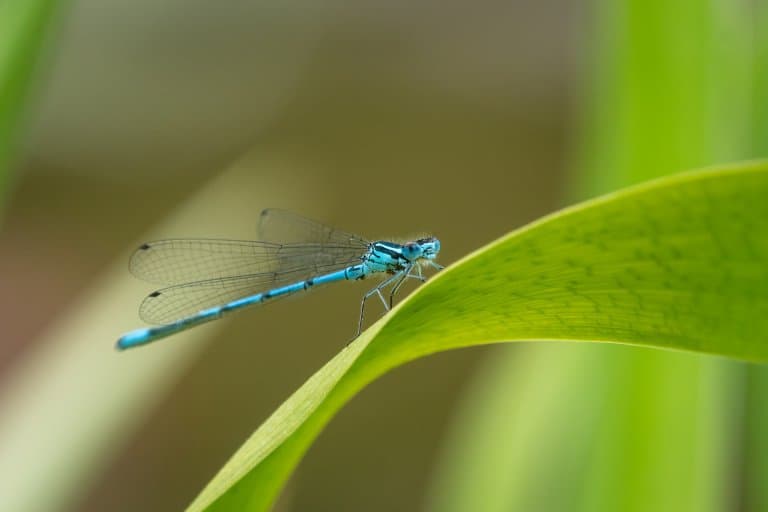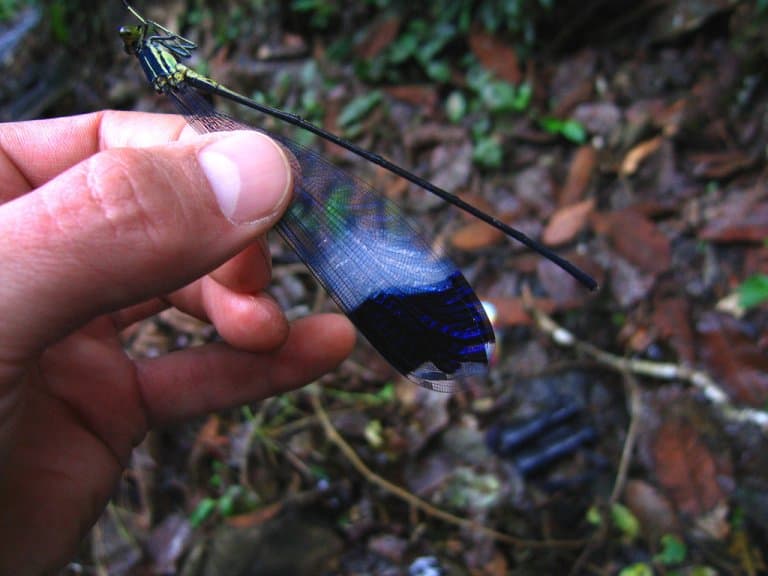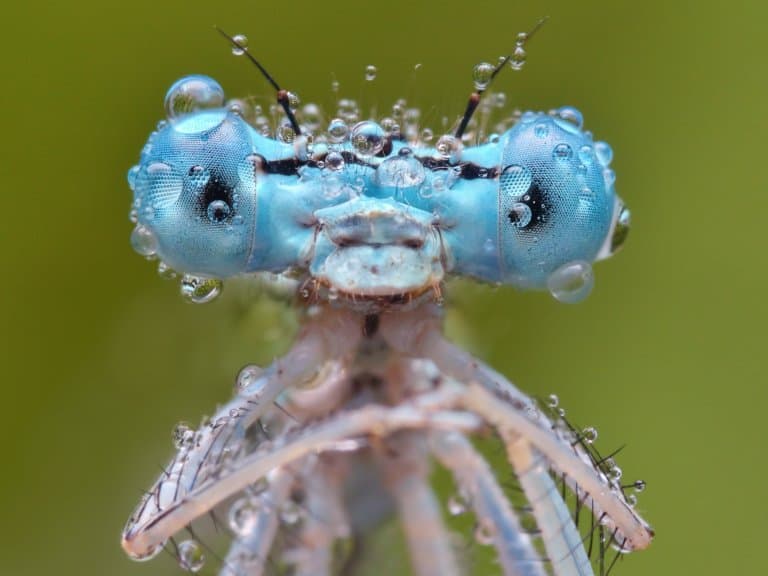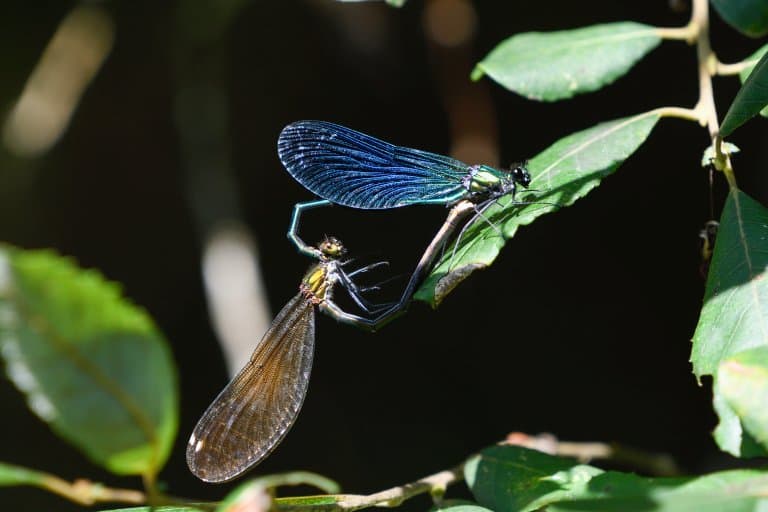Damselfly Profile
There’s a lot of confusion over the various forms of seemingly ephemeral, water-based flutterers.
Two of the most commonly confused are the dragonfly and the damselfly. But it’s a simple matter to tell them apart. Dragonflies are commonly found in caves, sitting on piles of gold. Damselflies are the hapless kidnapped victims that, as a knight, you’re supposed to go and rescue from them! We joke.
Damselflies are of course, flying insects that are smaller and slimmer than dragonflies and found on every continent except Antarctica.

Damselfly Facts Overview
| Habitat: | Near water: rivers, lakes, brackish estuarine, etc |
| Location: | Worldwide except Antarctica |
| Lifespan: | One year to several, depending on the species |
| Size: | Smallest are 18 mm (0.71 in), largest 190 mm wingspan |
| Weight: | <1g |
| Colour: | Varied, usually brown in juveniles, brightly coloured in adults |
| Diet: | Insects |
| Predators: | Birds, bats, frogs, fish, mammals |
| Top Speed: | Unknown |
| No. of Species: | More than 2000 |
| Conservation Status: | From Least Concern to Critically Endangerd (IUCN) |
Damselflies will inhabit areas around wetlands, required for their larval development.
They are gentler, smaller, and more sensitive than their notoriously powerful dragonfly cousins. Yet, they’re still a force to be reckoned with and occupy a very similar niche as agile predators both in the water and in the air.
Both as aquatic nymphs and as flying adults they will actively hunt and eat other insects. Adult damselflies will catch and diet on flies, mosquitoes and small insects.
Their sensitivity makes them handy as indicator species and tells us how messed up our water supply is. They’re also pretty and can be worn as a brooch.
Interesting Damselfly Facts
1. They’re very much like dragonflies
Dragonflies and damselflies are both in the order Odonata, which is an enormous group of mostly predatory flying insects, and there are something like 6,000 or more species of these described.
Damselflies, like dragonflies, have been around since before the Land Before Time, and their earliest larval fossils date back to 350 million years. Around that time, there was no separation between damselflies and dragonflies, and these animals would have been some common ancestor with traits of both.
Their divergence is harder to pinpoint, but it happened before the dinosaurs, perhaps around 300 million years ago. Both these lineages are some of the most ancient flying insects still around today and could be considered living fossils. But in that time, they have also developed identifying features that tell them apart.
The easiest way is to look at the wings when they land. Dragonflies lay their wings out to the side, manspreading them for all to admire. Damselflies are more demure, placing their wings gently together on their backs to cover their butts.
If you’re looking at their nymph stage, these don’t have wings and will be underwater. You can tell a damselfly larva by its three-pronged tail, looking a lot like a shrimp.

2. They are formidable aquatic predators
These nymphs don’t look like much but they’re actually dangerous predators if you’re a small animal living in their pond.
They have a sharpened lower jaw appendage, that rockets out like the mouth of a xenomorph, impaling and grabbing hold of beetle and fly larvae, and even fish if they’re small enough.
Those shrimpy appendages at the base of the abdomen are gills, and this allows them to spend the whole time submerged, where they patrol the waters looking for prey. During this period spent submerged, they’ll moult more than ten times before leaving the water to emerge as an adult.
Dragonfly nymphs are typically larger and more powerful than damselflies, so will be able to handle larger prey, but both are equally important to population control in their tiny, freshwater ecosystems.
3. Adults continue this rampage in the air
Their time spent as adults is generally less than that of their growth stages, but in this time they do eat, and they can even act as effective pest control.
Adult damselflies will hunt among long grasses, picking off small insects like mosquitos. They have excellent vision, from two, widely-separated compound eyes, that act as another distinguishing feature from dragonflies.
Large damselflies are even able to pluck spiders from the centre of their webs. 1
4. They’re widespread
Damselflies don’t have wide ranges, but they are found all over the world except Antarctica. Most breed and live around freshwater, but some occupy brackish environments too.
They’re not as robust as dragonflies, and this makes them much more sensitive to pollution and limits their range significantly in comparison, but they are a diverse group, and come in all shapes and sizes.
5. The largest damselfly has a 20cm wingspan
While the vast majority are smaller than dragonflies, the largest damselflies are bigger. Helicopter damselflies, the ones who eat spiders, can grow up to 13cm in body length and almost 20cm in wingspan.
The largest species in the world is known as ‘Megaloprepus caerulatus’ or the blue-winged helicopter.
But even these giants are miniscule when compared with their early ancestors. The largest damselflies of the past would have measured around five times this size!
The diversity among this group of insects is partially a result of differing temperatures. In high temperatures, these insects grow faster, but to a smaller size. 2

6. They can accelerate their growth
But resources also appear to play a role in how fast damselflies can grow. When they’re born late in the season, they appear to be able to turbo-charge their development, eating particularly quickly to catch up.
Again, this reduces the size of their final form, but this represents a behavioural adaptation to times of need, and one that studies have shown can also be tied to predator presence.
These ancient insects have had a long time to hone their adaptations to changes in environments, and the ways in which they do this are still coming to light. Sadly, humans are proving to be too much to handle for some species. 3
7. Some are endangered
Molokai damselflies come from an island way out in the remotest parts of the Pacific Ocean. Their plight isn’t well documented, but what is known is that they are one of the species of damselfly closest to extinction.
Invasive animals appear to be the major problem, as feral ungulates destroy habitats and disrupt insect communities.
Next door, the Pacific Hawaiian Damselfly is also endangered. Again, feral ungulates, and invasive cats, as well as habitat alteration by agricultural presence are all causing the species harm. Some are likely to be collected, as they’re rare and valuable samples.
Another species in trouble is the beautifully named Glittering Demoiselle, which is a victim of water pollution in the Northernmost tip of Africa. Climate change is also drying up its habitat.
Damselflies are sensitive to changes like this, which makes them ideal canaries for impending catastrophes. 4
8. They’re indicator species
We call species like this indicator species, as their presence indicates a level of health in the ecosystem.
The larvae of different species have different requirements in regards to the depth and quality of the water, and how fast it moves, etc.
As such, a sample of the species available can tell ecologists a lot about the ecosystem they’re looking at.

9. They can clap
Their ability to neatly clasp together their wings has allowed damselflies a certain behaviour that dragonflies can’t figure out.
Wing-clapping is not very well understood, but it appears to be a deliberate form of communication. It’s debatable whether this is a territorial act, a method of cooling down a courtship ritual, or maybe something else entirely.
The fact that we don’t know reflects how much dragonflies steal the limelight when it comes to studying Odonates.
10. Damselflies have elaborate courtship behaviours
Males are often more brightly colored than females, and their courtship behaviours are designed to show off their color, fitness and flying prowess to females.
They will fly in front of females and perform flight displays including wing clapping, thrusting, fluttering, and alternating fast and slow wingbeats!
Like dragonflies, they will mate by forming a shape known as a heart or a wheel and through indirect insemination – where the female will pick up sperm from the base of the males abdomen.
There have been some recorded cases of sexual cannibalism where females of Ischnura graellsii will then eat males!
The eggs will then be deposited into water plant tissues.

11. They make good jewellery
Damselflies have been recognised as pretty for as long as humans have existed. Their heart-shaped mating dance only endears us to them more, and when humans like an animal, they tend to show their appreciation by killing and wearing it.
Damselflies have been killed and worn for centuries, and metal replications are still popular today. Some say they’re symbols of growth and determination, but they’re primarily appreciated as shiny thing that looks pretty. 5 6
Damselfly Fact-File Summary
Scientific Classification
| Kingdom: | Animalia |
| Phylum: | Arthropoda |
| Class: | Insecta |
| Order: | Odonata |
| Suborder: | Zygoptera |
| Family: | 27-40 families |
Fact Sources & References
- “Damselflies”, Bumblebee.org.
- (2023), “Explaining global body size variation in dragonflies and damselflies: temperature or predators?”, Biogeography.News
- Frank Johansson (2001), “LIFE HISTORY PLASTICITY IN A DAMSELFLY: EFFECTS OF COMBINED TIME AND BIOTIC CONSTRAINTS”, esa journals.
- “Pacific Hawaiian Damselfly”, IUCN Red List.
- Robert K. Liu (2001), “The Symbolic Importance of Insects in Jewelry”, JSTOR.
- Ania Emmett (2019), “THE DEEPER MEANING OF INSECT JEWELLERY”, Henryka.
